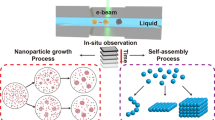Abstract
Thermal decomposition of ammonium hexachloroiridate(IV) in inert and reducing atmospheres are studied by X-ray photoelectron spectroscopy (XPS) and scanning electron microscopy (SEM). Particular attention is paid to the formation of metallic iridium particles. The processes of thermal decomposition proceed similarly in an inert atmosphere and in a vacuum as is evidenced by equal charge states of Ir, Cl, and N at different decomposition stages in these two cases. According to XPS data, the decomposition process can be described as consisting of three main stages. At the first stage, an intermediate product with atomic charge states corresponding to {Ir(NH3)xCl6−x}(x−3) (1 ≤ x ≤ 3) and metallic iridium are formed. At the second stage, atomic charge states indicate formation of {IrClx}3−x, NH4Cl. The metal nanoparticles appearing at these stages have different shapes: spherical, “flakes”, dendritic networks. The final decomposition product (metallic iridium) is agglomerates of regularly shaped spherical nanoparticles of uniform sizes. The process of thermal decomposition in a reducing atmosphere leads to the formation of nanoporous metal crystallites with a shape similar to that of the initial complex salt. Such crystallites are formed as a result of complicated channels that are developed due to the release of gaseous products (N2 and HCl) and are directed from the bulk of the crystallite to its surface. The atomic charge states of the intermediate decomposition product correspond to {IrClx}3−x.
Similar content being viewed by others
References
T. I. Asanova, I. P. Asanov, M.-G. Kim, E. Yu. Gerasimov, A. V. Zadesenets, P. E. Plyusnin, and S. V. Korenev. J. Nanopart. Res., 2013, 15, 1994.
T. Asanova, I. Asanov, A. Zadesenets, E. Filatov, P. Plyusnin, E. Gerasimov, and S. Korenev. J. Therm. Anal. Calorim., 2016, 123, 1183.
T. I. Asanova, I. P. Asanov, M. G. Kim, and S. V. Korenev. J. Struct. Chem., 2017, 58(5), 901–910.
S. V. Korenev, A. B. Venediktov, Y. V. Shubin, S. A. Gromilov, and K. V. Yusenko. J. Struct. Chem., 2003, 44(1), 46.
K. V. Yusenko, S. Riva, P. A. Carvalho, M. V. Yusenko, S. Arnaboldi, A. S. Sukhikh, M. Hanfland, and S. A. Gromilov. Scripta Materialia, 2017, 138, 22.
Q. Kong, F. Baudelet, J. Han, S. Chagnot, L. Barthe, J. Headspith, R. Goldsbrough, F. E. Picca, and O. Spalla. Sci. Rep., 2012, 2, 1018.
T. Asanova, I. Asanov, I. Kantor I., S. Korenev, and K. Yusenko. Phys. Chem. Chem. Phys., 2016, 18, 33134.
S. A. Martynova, P. E. Plyusnin, T. I. Asanova, I. P. Asanov, D. P. Pishchur, S. V. Korenev, S. V. Kosheev, S. Floquet, E. Cadot, and K. V. Yusenko. New J. Chem., 2018, 42, 1762.
T. I. Asanova, I. P. Asanov, M.-G. Kim, M. Gorgoi, J. Sottmann, S. V. Korenev, and K. V. Yusenko. New J. Chem., 2018, 42, 5071.
V. I. Bukhtiyarov, V. I. Zaikovskii, A. S. Kashin, and V. P. Ananikov. Russ. Chem. Rev., 2016, 85(11), 1198–1214.
E. O. Pentsak, A. S. Kashin, M. V. Polynski, K. O. Kvashnina, P. Glatzel, and V. P. Ananikov. Chem. Sci., 2015, 6, 3302.
S. Sun, G. Zhang, N. Gauquelin, N. Chen, J. Zhou, S. Yang, W. Chen, X. Meng, D. Geng, M. N. Banis, R. Li, S. Ye, S. Knights, G. A. Botton, T.-K. Sham, and X. Sun. Sci. Rep., 2013, 3, 1775.
M. P. Seah, M. E. Jones, and M. T. Anthony. Surf. Interface Anal., 1984, 6, 242.
B. D. Elissa, A. Katrib, R. Ghodsian, B. A. Salsa, and S. H. Addassi. Int. J. Quantum Chem., 1988, 33, 195.
S. Tanuma, C. J. Powell, and D. R. Penn. Surf. Interface Anal., 2003, 35, 268.
V. I. Nefedov. Russ. J. Coord. Chem., 1978, 4, 1283.
V. I. Nefedov and M. A. Porai-Koshits. Mater. Res. Bull., 1972, 7, 1543.
V. I. Nefedov. Russ. J. Coord. Chem., 1975, 1, 291.
E. Papirer, R. Lacroix, J.-B. Donnet, G. Nansé, and P. Fioux. Carbon, 1995, 33, 63.
A. F. Pérez-Cadenas, F. J. Maldonado-Hódar, and C. Moreno-Castilla. Carbon, 2003, 41, 473.
E. W. Ong and J. Eckert. Chem. Mater., 1994, 6, 1946.
K. Shimizu, A. Shcukarev, and J.-F. Boily. J. Phys. Chem. C, 2011, 115, 6796.
G. Meyer and A. Möller. J. Less-Common Met., 1991, 170, 327.
A. Möller and G. Meyer. Z. Anorg. Allg. Chem., 1994, 122, 1185.
Y. Shubin, P. Plyusnin, and M. Sharafutdinov. Nanotechnology, 2012, 23, 405302.
Acknowledgments
The authors thank E. Yu. Filatov for the X-ray diffraction analysis of the initial complex salt.
Funding
The work was partially carried out within the State Assignment of NIIC SB RAS in the field of basic research. The study was supported by the Russian Foundation for Basic Research (project No. 19-02-00308a).
Author information
Authors and Affiliations
Corresponding author
Ethics declarations
The authors declare that they have no conflict of interests.
Additional information
Additional Information
The studies were performed using the equipment of the Common Use Center “National Research Center for Catalyst Studies”.
Russian Text © The Author(s), 2020, published in Zhurnal Strukturnoi Khimii, 2020, Vol. 61, No. 3, pp. 412–423.
Rights and permissions
About this article
Cite this article
Asanova, T.I., Asanov, I.P., Maksimovsky, E.A. et al. Studying the Process of (NH4)2[IrCl6] Thermal Decomposition by X-Ray Photoelectron Spectroscopy and Electron Microscopy. J Struct Chem 61, 388–399 (2020). https://doi.org/10.1134/S0022476620030063
Received:
Revised:
Accepted:
Published:
Issue Date:
DOI: https://doi.org/10.1134/S0022476620030063




